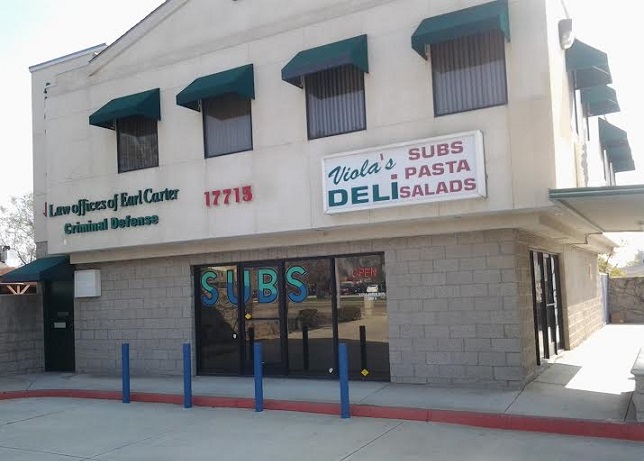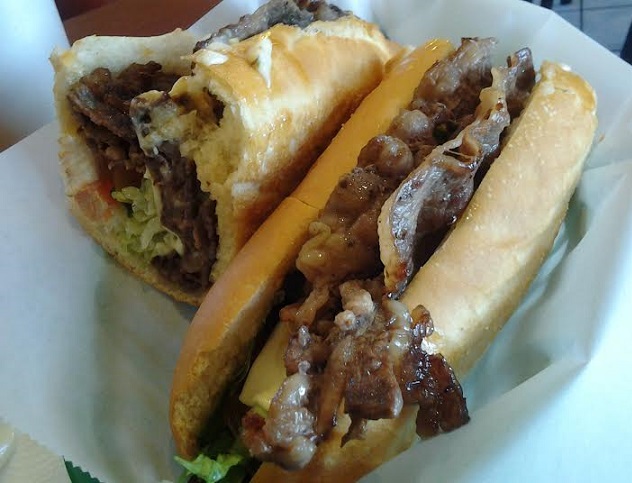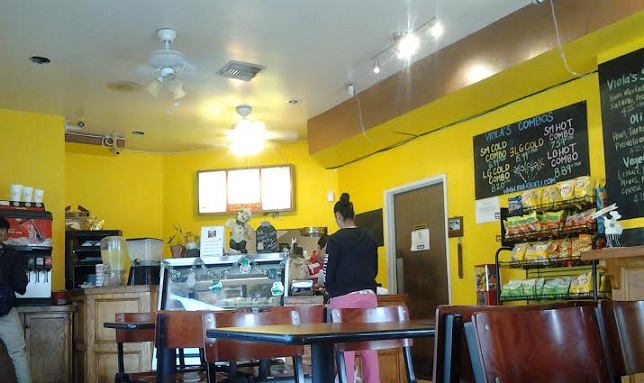[So, after a four-week hiatus, “A to Z” returned to the newspaper, rested and refreshed. I had to acknowledge the grungier side of Pomona somehow, and devoting the letter N to the city’s ubiquitous 99-cent stores was the way to go.
I asked Shawn Davis, an Arts Colony acquaintance, if she knew anybody who doted on these stores and she put me in touch with Willie Campos. Willie proved to be a hilarious tour guide, as you’ll see. He remains an Arts Colony fixture and just the other day handed me a flier for the karaoke show he hosts at the Characters sports bar each Sunday night. If I ever bring myself to break my personal karaoke ban, that’s the show I’ll go to.
As for updates, the Indian Hill Discount Store got a new sign a year or so ago identifying itself as the Indian Hill Discount Sore, a misspelling that’s gone from astonishing to kind of sad the longer it remains. Sigh.
This column was originally published Nov. 14, 2004.]
‘A to Z’ blowout: Nothing here more than 99 cents!
Welcome back to “Pomona A to Z,” in which we shine a spotlight on that venerable city’s splendors, one letter at a time.
Today brings us to the letter N. In a nutshell, Pomona has numerous and nonpareil nominees. Numbered among them:
* Neon, still lighting up signs on many mid-century buildings in Pomona, often originated by Pomona’s Williams Sign Co., in existence since 1930.
* NASA/JPL Educator Resource Center, established in the Village at Indian Hill by the two agencies to jet-propel science materials into Pomona schools.
* Newspapers, including the Inland Valley News, the area’s only black-owned paper, and the Butcher Paper, a journal coming soon to the Arts Colony.
* National Hot Rod Association Museum at Fairplex, a nifty place for car nuts.
Not to be narrow-minded, but our N is none of the above. Instead, we’ll recognize Pomona for its niche as the discount capital of the Inland Valley.
N is for 99 cents stores.
True, this isn’t the most glamorous honor, but discount shopping — think Indoor Swap Meet — is part of Pomona’s identity.
Drive any major street here and you’ll see some entrepreneur’s variation on the 99 Cents Only chain’s concept in almost every strip mall.
They have such names as 99 Cents Plus or, for people who want to save a penny, 98 Cents Plus. My personal favorite, Indian Hill Discount Store, bears the Chinese menu-like motto “Nothing Over 99 Cents Except Few.”
My tour guide to this world was Willie Campos, a free spirit known in the Arts Colony for his love of cheap eats and treats.
“Everybody calls me Free Willie because I get everything for free,” Campos told me. “I’m going to write a manual on how to live for free.”
In the meantime, Campos led me around the 99 Cents Only Store on Holt Avenue, conveniently located within walking distance of his house. Visiting the chain store is one of the bright spots of his day.
“I know where every single item in this store is,” Campos bragged.
He took me up and down the aisles, grabbing random items and shouting, “This would be $2.50 at Stater Brothers! Look at this. It’s only 99 cents!”
Campos especially likes the Gourmet Fancy Foods section, where he sometimes picks up canned salmon. “I put this on bread with mayonnaise. It’s better than tuna,” he confided.
A 50-year-old with such disparate jobs as truck driver, mobile disc jockey and environmental engineer, Campos has been shopping at discount stores for a decade.
Although he first thought they were for poor people, he’s come to believe they give consumers what they want: low, low prices. Grocery stores are cutting their own prices to compete, he said. Not that he goes there.
“I do all my shopping here!” Campos exclaimed.
He loaded a basket with two Gary Cooper DVDs in paper sleeves, three rolls of toilet paper, four Ginseng drinks (priced at two for 99 cents), a two-pack of John Morrell smoked sausage, a razor and three containers of shredded Gouda cheese.
Grand total: $10.33.
Outside the store, Campos wiped his forehead with a handkerchief.
“I’m exuberant with my great purchases,” he admitted.
Nearby in the same strip mall is La Barata Discount Mart, a mom-and-pop outlet squeezed into a narrow storefront.
It’s these sort of places that spawned the 99 Cents Only chain, Campos said, adding cultural anthropologist to his resume.
“They’re mostly ethnic stores. They started off like this: Little stores with goofy stuff. You never know what you’re going to find,” he said.
Manager Hugo Munoz said La Barata has morphed into more of a swap meet with items of all prices.
“We have to compete with the big guys. You have to carry stuff they don’t have,” Munoz said.
From there, Campos and I hit a couple of locally owned under-a-buck stores. I drove him to First Bargain 99 Cents on Holt Avenue, which Campos admires for its wide aisles and 98-cent glass picture frames.
On South Garey we found 99 Cost Bargain, where a car outside bore a bumper sticker reading “I have a black belt in shopping.”
Campos recalled that he once bought enough bargain-priced halogen lights at this store for his whole house.
As he had things to do and people to see, I drove him back to his car. (He’d saved money, I realized, by getting me to drive him around.)
“I can’t wait to get home,” Campos told me, thinking back on his morning’s big purchase, “and put some Gouda on a baked potato!”
(David Allen writes Sunday, Wednesday and Friday, normally.)



